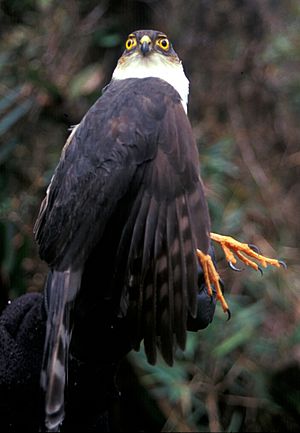Plain-breasted hawk facts for kids
Quick facts for kids Plain-breasted hawk |
|
|---|---|
 |
|
| Scientific classification | |
| Genus: |
Accipiter
|
| Species: |
ventralis
|
| Synonyms | |
|
Accipiter striatus ventralis |
|
The plain-breasted hawk (Accipiter ventralis) is a small bird of prey. It lives in South America, from Venezuela down to western Bolivia. Scientists often think it's a type of sharp-shinned hawk. But some experts believe it's actually its own species, or even one of three different species. These include the white-breasted hawk and the rufous-thighed hawk. It's a bit of a puzzle for scientists to figure out!
Contents
About the Plain-breasted Hawk
Scientists are still trying to understand if the plain-breasted hawk is a separate species. They look at things like where the birds live and how they look. For example, these hawks live in different areas and have different feather colors. This makes some scientists think they are unique species. However, more studies are needed to be sure.
What Does It Look Like?
The plain-breasted hawk is a small bird. Male hawks are about 23 to 30 cm (9.1 to 11.8 in) long. Their wings can spread from 42 to 58 cm (17 to 23 in) wide. They weigh about 82–115 g (2.9–4.1 oz).
Female hawks are much bigger than males. They are about 30% longer and weigh over 50% more. Females measure 29 to 37 cm (11 to 15 in) long. Their wingspan is 58 to 68 cm (23 to 27 in). They weigh between 150 to 219 g (5.3 to 7.7 oz).
These hawks have short, wide wings. Their tails are medium-length with black and gray bands. The tip of the tail can be slightly notched or rounded. Their legs are long, thin, and yellow. They have a black, hooked beak and yellowish skin around it.
Feather Colors
Plain-breasted hawks can have different feather colors. This is called being polymorphic.
- The most common type has dark gray upper parts. Their undersides are white with reddish-brown or buff marks.
- Some hawks are a "white morph." They have bluish-gray upper parts. Their undersides are all white, except for reddish-brown thighs.
- A rare "dark morph" hawk is mostly sooty black. These birds sometimes don't have reddish-brown thighs.
Female hawks usually have lighter undersides than males of the same color type. Most adults have yellow eyes. Young hawks have dark brownish upper parts with reddish edges. Their undersides are white with brown streaks.
Where Do They Live?
The plain-breasted hawk lives in the mountains of northern Venezuela and Colombia. They also live south through the Andes mountains. You can find them in Colombia, Ecuador, Peru, and central Bolivia.
There is also a separate group of these hawks. They live in the Tepuis, which are flat-topped mountains, in southern Venezuela. They likely live in nearby parts of Brazil too. These hawks usually stay in one area and do not migrate far.
What Is Their Habitat Like?
Plain-breasted hawks live in high places. They prefer upper tropical to temperate highlands. You can find them mainly at altitudes of 300–3,000 m (980–9,840 ft). Sometimes they are seen closer to sea-level or as high as 4,000 m (13,000 ft).
What Do They Eat?
These hawks are skilled hunters. They often surprise their prey from hidden spots. They can also fly very fast through thick trees and bushes. This hunting style can be risky for the hawk.
Most of their food is small birds. They eat songbirds like sparrows, wood-warblers, finches, wrens, and thrushes. Male hawks usually hunt smaller birds. Females go after larger birds like thrushes. This helps them avoid competing for food.
Sometimes, these hawks visit backyard bird feeders. This is because many small birds gather there, making them easy targets. Hawks often pluck feathers from their prey on a perch. Rarely, they might also eat small rodents, lizards, frogs, snakes, or large insects.
Reproduction and Life Cycle
Plain-breasted hawks build their nests from sticks. A female hawk usually lays 4 to 5 eggs, but sometimes up to 8. Each egg is about 37.6 mm × 30 mm (1.48 in × 1.18 in) and weighs around 19 g (0.67 oz).
The eggs hatch after about 30 days. The mother hawk stays with the young for 16 to 23 days. During this time, the father hawk protects the nest and hunts for food. The young hawks learn to fly when they are about a month old. They still depend on their parents for food and safety for another four weeks. Scientists believe their breeding habits are very similar to those of the sharp-shinned hawk.
Conservation Status
The plain-breasted hawk is quite common. However, they can be hard to spot because they are secretive. For now, they are considered safe and not in danger.
See also
 In Spanish: Gavilán andino para niños
In Spanish: Gavilán andino para niños

